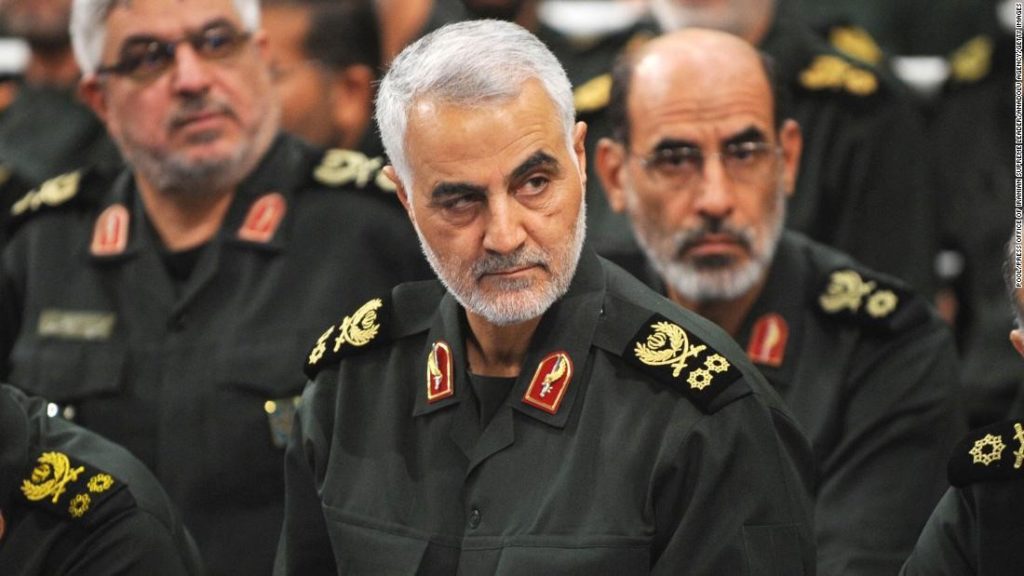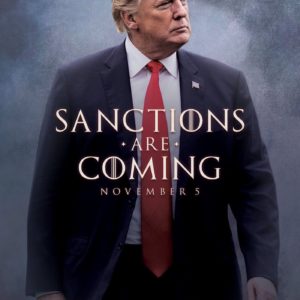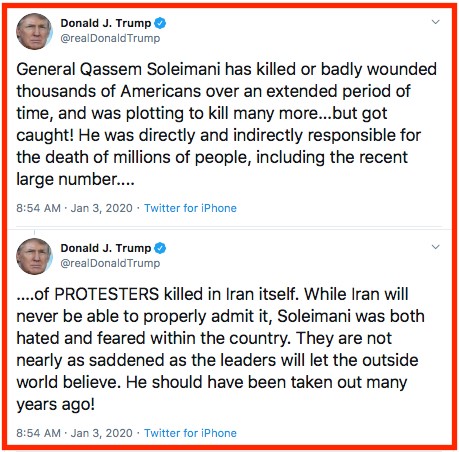By: Gracie Swind, Contributing Writer
On Jan. 3, 2020, Iran’s Major-General Qasem Soleimani, as well as two other Iranian militia leaders, were killed via drone strikes approved by U.S. President Donald Trump. Iran responded with a counterstrike against the United States on two American bases located in Iraq, lightly injuring over 50 U.S. soldiers, but fortunately killing no one.
Since that strike, Iran has declared its retaliation as revenge for the killing of Soleimani, and the impending threat of war has subsided. In the wake of these early January counter-strikes, most Americans were concerned with the possibility of the country going to war.
Over the course of the past two decades, Soleimani has been instrumental in countless Iranian state-run terrorist attacks against the United States, and has spearheaded the production of black-market high-grade mines specifically manufactured for killing Americans in Iraq. Soleimani’s actions justify his killing in the eyes of many Americans, including the President himself, while others still widely condemn the attack as imperialistic.

“If you attack another leader it is like an attack of war, and you accept the fact you could be going into war,” said Rimanelli.
Dr. Marco Rimanelli, a tenured professor in Political Science and International Security at Saint Leo University, says that the origin of the recent strikes traded by the United States and Iran can be traced back to contrasts building-up since the 1979 Iranian Islamic Revolution.
“The first thing we need to understand is that Iran is a…theocratic dictatorship controlled by a religious caste,” explained Dr. Rimanelli. “Iran’s religious fundamentalists are Shi’a, a sub-group of Islam. The majority of Muslims – 90% – are Sunni, while the minority [10%] are Shi’a, concentrated predominantly in Iran, southern Iraq, Lebanon and few other Middle Eastern countries.”
According to Dr. Rimanelli, “When Iran became…an Islamic fundamentalist state [in 1979], it [also became]a terrorist state sponsoring its own brand of religious extremism abroad against the U.S., Israel and its Arab neighbors.”
![“Millions came to see Soleimani. Soleimani was a terrorist leader [and]killer, but in an Islamic fundamentalist society he was a symbol of the Pasdaran so everybody tied to the government went to his funeral,” explained Rimanelli.](https://lionsprideonline.com/wp-content/uploads/2020/03/iran2-1024x683.jpg)
“Millions came to see Soleimani. Soleimani was a terrorist leader [and]killer, but in an Islamic fundamentalist society he was a symbol of the Pasdaran so everybody tied to the government went to his funeral,” explained Rimanelli.
As an Islamic fundamentalist state, the religious leaders hold the most power; they control who is elected into power and heavily influence the prime minister. Their key tool for controlling the people is not the government, but the party militia, also called the revolutionary guard or Pasdaran.
American interest and involvement in the middle-east fluctuated over both the Obama and Trump terms, eventually being seen as low-priority in the eyes of the American people and leading troops to be pulled from the region. When Obama pulled American troops from Iraq in 2011, U.S. forces lost their local influence and Iran took full control.
![“Technically, under the UN you cannot kill anybody, but the Americans have killed – over a long time – [many]terrorist [leaders],” said Rimanelli. Since the fundamentalist state of Iran is seen as a terrorist organization, the assassination of Soleimani is uncontested by the UN.](https://lionsprideonline.com/wp-content/uploads/2020/03/iran3-1024x576.jpg)
“Technically, under the UN you cannot kill anybody, but the Americans have killed – over a long time – [many]terrorist [leaders],” said Rimanelli. Since the fundamentalist state of Iran is seen as a terrorist organization, the assassination of Soleimani is uncontested by the UN.
In 2015, the U.S., Europe, NATO, United Nations, and Russia convinced Iran to sign a 15-year arms-control nuclear deal in exchange for lifted sanctions and returned funds. Iran’s decision to continue growing their military and spending money on wars lead directly to Trump’s immediate cancellation of the nuclear deal upon his election, as well as the creation and imposition of new sanctions on Iran.
Although Trump pulling out of JPOA did not negate the deal for the rest of the parties involved, the deal was still largely unraveled. With the U.S. refusing to do business with any companies that fraternized with Iran, European countries cut off trade with Iran almost immediately, as trade revenue from America far outweighed their trade boons in Iran.
“The [American] sanctions have completely destroyed the Iranian economy and brought revolt in the street,” explained Dr. Rimanelli. The economic sanctions forced Iranian citizens, who knew about the outside spending and were already not pleased, to revolt, “saying ‘we know you’re wasting money outside, now we’re in a [worse]situation, what to do?’”
As the number two in all Iranian action, Soleimani was the most influential player in Iranian state-sponsored terrorism against America. Although the U.S. has wanted to eliminate Soleimani for a while, the timing was never right, mostly due to past U.S. Administration’s reluctance to face a potential risk of escalation and even war with Iran.
“What precipitated the decision was that the Iranians thought that Trump was weakened by this…troubled impeachment,” said Dr. Rimanelli. “Emboldened, the Iranians in Syria and Iraq decided [to]coordinate [a march on the U.S. Embassy in Baghdad to expel]Americans from Iraq.”

Since Trump imposed his sanctions on Iran, the European Union has imposed their own sanctions on the Iranian government, further crippling their economy.
“Because the Iranians have done many things before…and the Americans had not reacted because nobody had died, they took this not as a sign of restraint, but as a sign of weakness,” said Rimanelli.
In the last weeks of 2019, a rocket attack on an Iraqi military base killed a U.S. civilian contractor and wounded several U.S. soldiers. The contractor’s death prompted a renewed Iran-U.S. confrontation, leading to the U.S. strikes on a number of Iraqi and Syrian sites, as well as the assassination of Soleimani.
The attack was orchestrated by an unmanned drone that fired a missile into Soleimani’s convoy traveling on the Baghdad Airport highway, blowing up two cars and killing Soleimani, as well as two other leaders in the Iranian militia. Furious, the Iranians requested American forces to leave Iraq, although to no end.
In response to the assassination, Iran launched a range of missiles on the two American bases in Iraq, hoping for a U.S. response that would allow them to turn the tides of the civilian revolts to focus on America as their subject of contempt. The missiles did not kill any Americans, yet wounded around 50 soldiers, most of which have been brought back to the United States for medical treatment.
President Trump chose not to respond to the retaliation strike, but Iran, anticipating an attack from the U.S., mistakenly shot down a civilian jetliner that they believed to be an American plane coming to drop bombs. The Iranian government tried to cover up the attack as an American act of terror, but after failing to bury the evidence, they had to acknowledge that they had shot the plane down; the deception of the Iranian government prompted new waves of civilian protest against the Iranian government.

When the missiles fired on Soleimani and his entourage, he was not around any civilians, limiting the impact on innocents.
“Their country is getting so unruly,” said Dr. Rimanelli. “with people wanting a civil life like you and I, and not wanting religious oppression…[they]must constantly feed the fires of religious conversion by saying ‘the capitalist enemy are coming against us.’”
Dr. Rimanelli concluded by saying that the Iranian government is very weak. While they have retained other minor military leaders, they no longer have Soleimani.
“They will continue to rely on the Pasdaran, but they got a message,” said Dr. Rimanelli. “They messed with the Americans in Iraq and threatened American bases strongly and they lose top leaders.”
“Why [did]they not kill him [sooner]? For twenty years they never killed him. Because the cost of war was deemed too big, and Trump wanted to teach a lesson short of going to war. He took a gamble – he won. Had those missiles shot in revenge killed Americans, then [you would’ve had]a repercussion,” explained Dr. Rimanelli. “In the process, Trump has shown that he was strong, as well as very unpredictable, and that keeps scaring everybody.”

![Sending Messages via Missiles: Analyzing the latest U.S.-Iran Clash “Technically, under the UN you cannot kill anybody, but the Americans have killed – over a long time – [many] terrorist [leaders],” said Rimanelli. Since the fundamentalist state of Iran is seen as a terrorist organization, the assassination of Soleimani is uncontested by the UN.](https://lionsprideonline.com/wp-content/uploads/2020/03/iran3-702x336.jpg)



